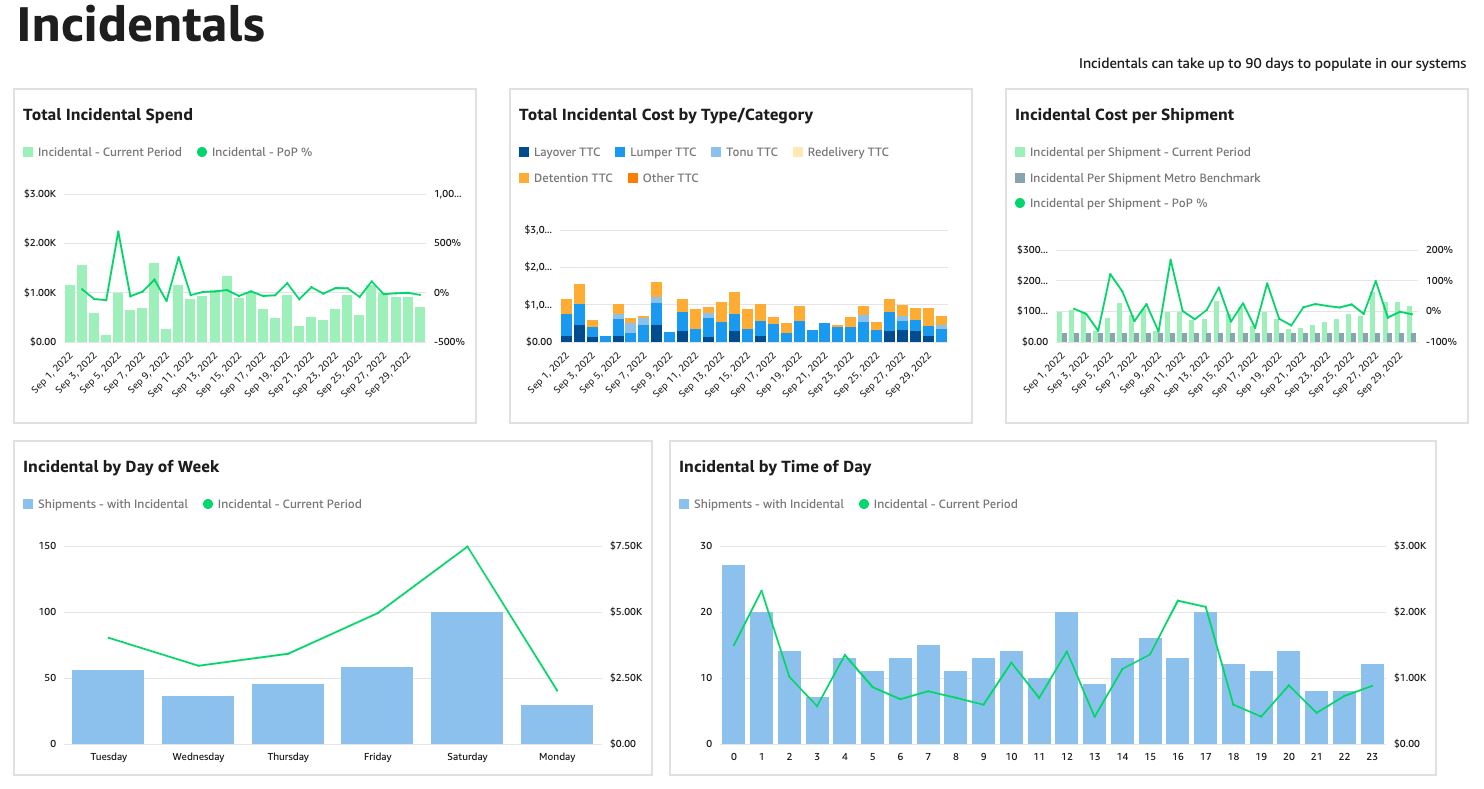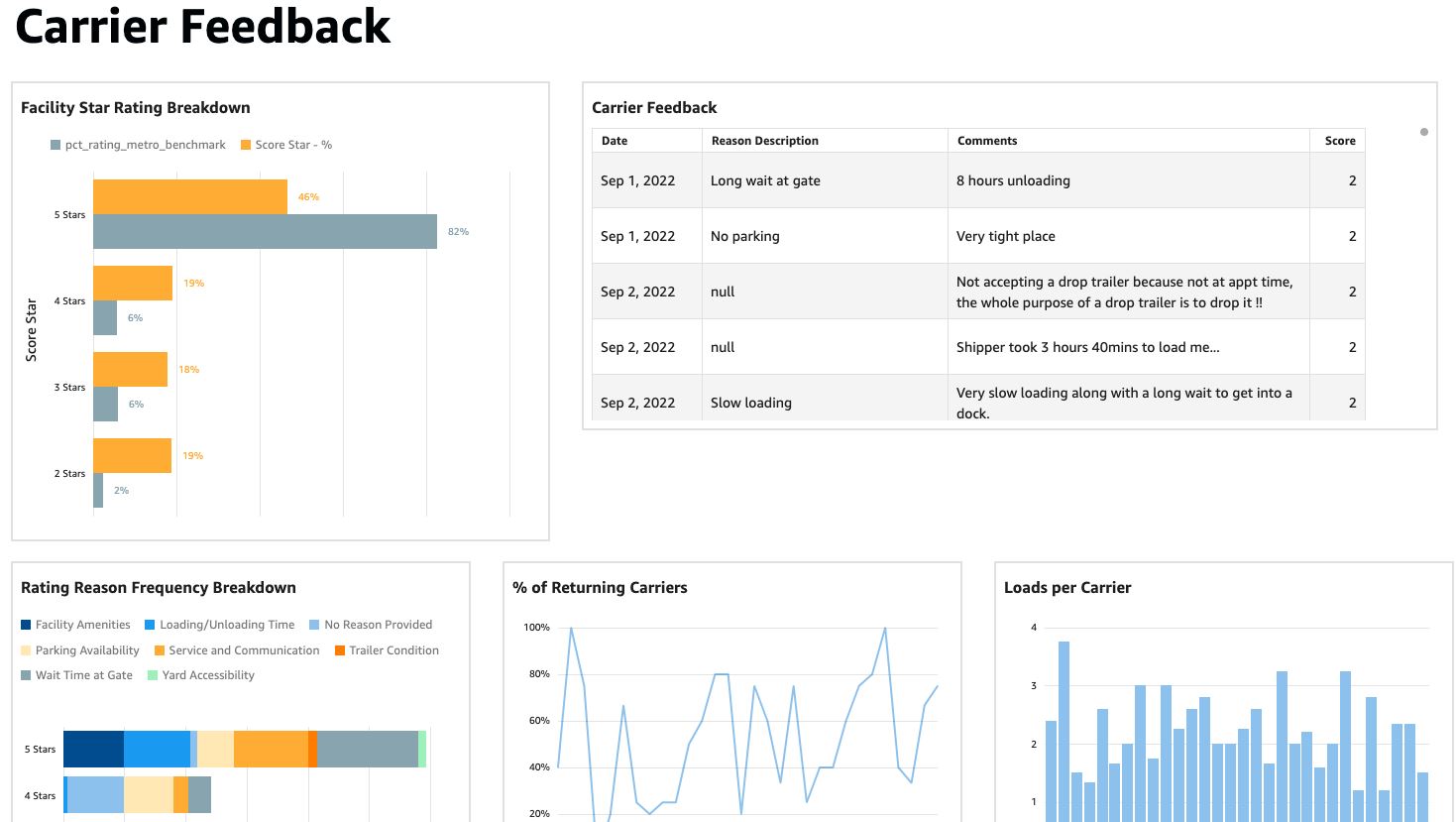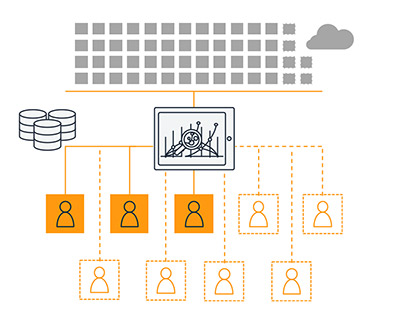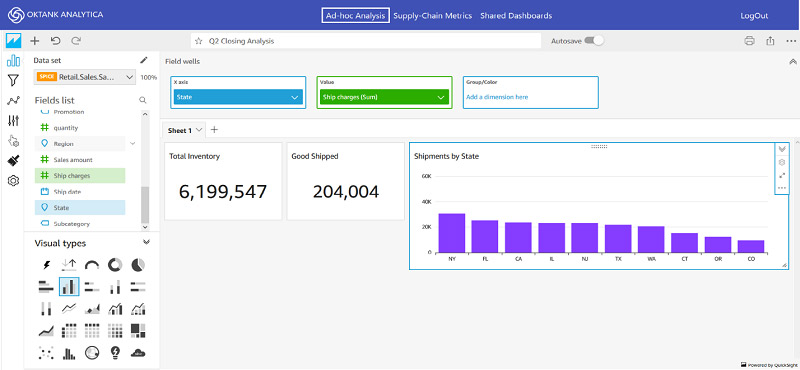Post Syndicated from Dorothy Li original https://aws.amazon.com/blogs/big-data/convoy-uses-amazon-quicksight-to-help-shippers-and-carriers-improve-efficiency-and-save-money-with-data-driven-decisions/
Convoy is the leading digital freight network in the United States. We move millions of truckloads around the country through our connected network of carriers, saving money for shippers, increasing earnings for drivers, and eliminating carbon waste for our planet. In 2015, Convoy started a movement toward efficient freight. We build technology to find smarter ways to connect shippers with carriers while solving some of the toughest problems that result in waste in the freight industry.
As a digital freight network, Convoy uses machine learning and automation to efficiently connect shippers and carriers. As our marketplace grows, it creates a flywheel effect that benefits both sides. As more shippers join the network, drivers have better options, fewer empty miles, and fewer wasted hours, allowing them to earn more per day. As more carriers join the network, capacity increases and shippers see lower costs and higher service quality. Convoy is on a mission to transport the world with endless capacity and zero waste.
Our digital freight network collects thousands of disparate data points and intelligently connects the dots to provide transparent visibility into freight operations. By providing transparency and insights into every step of the shipment lifecycle, shippers benefit from lower costs, reduced waste, and higher carrier loyalty. To surface these insights to customers inside our product, we needed a business intelligence (BI) tool that could not only handle our volume of data, but could provide at-a-glance insights through a user-friendly interface, empowering our customers to make data-driven decisions, and taking the guesswork out of resolving unexpected issues.
After reviewing our options and evaluating which would best meet our needs, we turned to Amazon QuickSight.
In this post, we discuss how QuickSight is helping us serve our customers with the insights they need, and why we consider this business decision a win for Convoy.
From disparate data points to at-a-glance insights
Our vast network of small carriers and owner-operators, totaling more than 400,000 trucks nationwide, provides meaningful data points through the Convoy app. We require carriers to use our app when hauling loads—this is how we provide GPS tracking on 95% of live loads and 100% of drop loads. It’s also how we collect robust data around dwell times, detention costs, and more. To date, we’ve captured more than 2.7 million facility reviews in the Convoy app.
We chose QuickSight because we needed ease in development. We wanted to be able to quickly build dashboards and get them in the hands of our customers. Because this is an externally facing tool, we had data privacy and governance requirements to consider as well. Especially important was that we needed granularity in row-level security. QuickSight provided what we needed out of the box, whereas the other BI platforms we considered did not. Additionally, QuickSight’s pricing would allow us to scale the platform as our user base continues to grow.
Connecting the dots with data
The challenges facing our customers are as varied as the landscapes our carriers travel through every day. From managing delays due to weather, traffic, and unpredictable load times on the carrier’s end, to lacking freight visibility and root causes of operational issues and inaccuracies in manual reporting on the shipper’s end, there is no shortage of opportunities to improve the status quo.
The following screenshot shows performance metrics, like dwell time and incidentals per shipment, plus breakouts that show incidental types and categories for each facility.

Where we strive to meet the needs of both shippers and carriers, we’re in a unique position to connect the dots to identify gaps on one end that have corresponding inputs on the other. The challenges shippers face are often driven by pricing, complexity, and reliability of transporting goods. For carriers, their challenges are more centered on earning predictable and consistent income with the least amount of time and effort invested in finding loads, building schedules, and adjusting to delays. Our customers have sophisticated internal analytics programs, but highly granular data or synthesized data from their vendors is rare. Finding ways to develop metrics and benchmarks for specific business entities (lanes, regions, facilities, and so on) meant we would need to learn and update our products quickly. QuickSight allows us to do that.
With so many data points and opportunities to turn them into key insights, the dashboards and visualizations QuickSight provides makes spotting trends and taking proactive measures to get ahead of minor issues before they become major problems easier than ever.
When reviewing our BI options, the following factors were front and center in our decision to go with QuickSight:
- Pace of development – We wanted to deliver insights to our customers quickly. The seamless integration of QuickSight with other AWS services had our dashboards up and running in no time.
- Secure access to data – With row-level authorization, QuickSight gives us the flexibility we need, along with the peace of mind knowing the data is secure.
- Scalable cost model – The QuickSight pricing model suits our needs, allowing us to scale based on usage.
When we first piloted our external insights product, we built a prototype with our previously used BI tool. Building future iterations with this same tool wasn’t feasible because it lacked functionality in several key areas. We needed to be able to join data from multiple sources, drill down into layers of data, and customize data based on the user accessing the information. In addition, because we were self-hosting, the overhead of scaling our footprint was going to be high. We did consider other solutions, but QuickSight was best able to offer all the features we needed, at the best price.
Visibility improves efficiency
With QuickSight, we were able to build an external-facing product for our shipper customers, helping them gain visibility into the health of their supply chain, which could then provide insights to make things run more efficiently.
The following screenshot shows incidentals, broken out by spend, type or category, and more.

With a visualization of how incidental costs break down, for example, they can see the cost of having a truck unloaded at a facility, the cost of canceling loads on a driver, the cost of having travers waiting at a facility, and more. With that visibility, our shipper customers can now begin to address systemic issues that can save them money, such as improving scheduling to reduce driver wait times.
The following screenshot shows a visualization on carrier feedback, which shippers could use to make improvements that provide a faster, smoother experience.

Future plans with partnering team expansions
They say that imitation is the purest form of flattery. Although that phrase is often used in the context of competitors who develop products and services that are suspiciously similar to an existing product or service, it can also apply to when good ideas are duplicated within an organization. That’s the case for us, in that our QuickSight adoption has drawn the attention and curiosity of partnering teams, who have reached out to us to understand our implementation specifics and the successes we’ve seen as a result.
We’re very happy with our QuickSight Embedded experience and look forward to continuing to iterate and expand its use for additional customer profiles and use cases.
To learn more about how you can embed customized data visuals, interactive dashboards, and natural language querying into any application, visit Amazon QuickSight Embedded.
About the Author
 Dorothy Li is Convoy’s CTO, overseeing Convoy’s Product and Engineering group and technology strategy, shaping and scaling the company’s innovation and industry-defining technology platforms. Prior to Convoy, Dorothy held leadership roles at Amazon, most recently as Vice President of BI and Analytics at AWS. During her more than 20 years at Amazon, Dorothy helped build out Amazon’s ecommerce platform and also led and collaborated on products that had visibly impacted customers around the world – from the initial launch of Amazon Prime, to Kindle, and at AWS where she focused on data analytics and BI. Dorothy received her Bachelor of Science at Brigham Young University and studies at Shanghai International Studies University.
Dorothy Li is Convoy’s CTO, overseeing Convoy’s Product and Engineering group and technology strategy, shaping and scaling the company’s innovation and industry-defining technology platforms. Prior to Convoy, Dorothy held leadership roles at Amazon, most recently as Vice President of BI and Analytics at AWS. During her more than 20 years at Amazon, Dorothy helped build out Amazon’s ecommerce platform and also led and collaborated on products that had visibly impacted customers around the world – from the initial launch of Amazon Prime, to Kindle, and at AWS where she focused on data analytics and BI. Dorothy received her Bachelor of Science at Brigham Young University and studies at Shanghai International Studies University.




 Dorothy Li is the Vice President and General Manager for Amazon QuickSight.
Dorothy Li is the Vice President and General Manager for Amazon QuickSight.